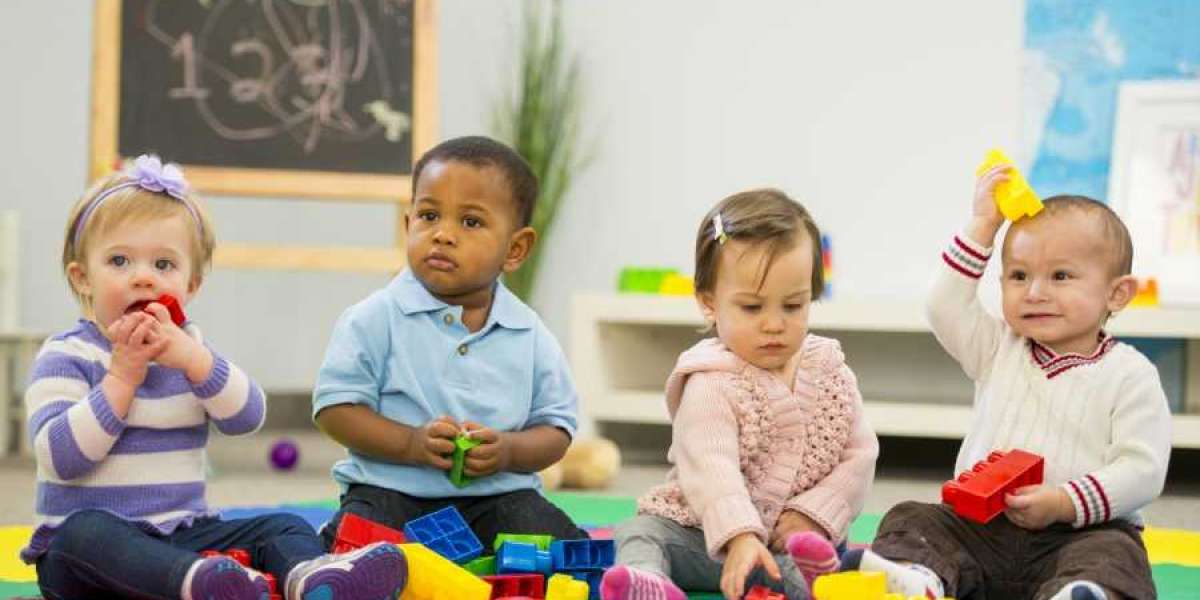Introduction to Separation Anxiety and Daycare
Are you experiencing separation anxiety before dropping off your child at daycare near you? You're not alone. Separation anxiety is a normal stage of development for young children and can be a difficult and emotional time for parents. To help ease your child's separation anxiety and make the transition to daycare easier, it's essential to understand what separation anxiety is, the signs and symptoms to look out for, and how to help your child cope.
What is Separation Anxiety?
Separation anxiety is a normal stage of development for young children, typically occurring between 8-14 months. Fear and distress happen when a child is separated from their primary caregiver. It is an emotional response to being left alone and a sign of a healthy attachment between a child and their caregiver.
Signs and Symptoms of Separation Anxiety
Separation anxiety can manifest in different ways. Some common signs and symptoms to look out for include:
• Crying or tantrums when being dropped off at daycare
• Becoming clingy or refusing to let you leave
• Difficulty sleeping or nightmares
• Refusing to eat or go to the bathroom while at daycare
• Difficulty with transitions or goodbyes
How to Help Your Child Cope?
You can do a few things to help your child cope with separation anxiety.
Prepare in advance:
- Talk to your child about daycare before their first day.
- Show them pictures of the daycare, the teachers, and other children.
- Explain the activities they will do and how long they will be there.
Build a routine: Establish a routine for your child before and after daycare to help them feel secure. Have a consistent drop-off and pick-up time, and do the same daily activities.
Create a comfort item: Have your child bring a comfort item to daycare, such as a stuffed animal, blanket, or photo of the family. This will help them feel more secure when you are not there.
Make goodbyes brief: When dropping your child off at daycare, make your goodbyes short and positive. Tell them you will be back soon and hug and kiss them.
Be consistent: It is essential to be consistent in your approach to separation anxiety. Do not give in to your child's demands or
The Signs and Symptoms of Separation Anxiety
Separation anxiety is a common issue for young children and can occur when a child is left with a caregiver or when the child is away from home. Separation anxiety can be difficult for both the child and the parent, but it is essential to recognize the signs and symptoms so that you can address your child's anxiety.
Common signs of separation anxiety include:
* Crying or clinging when it's time to leave
* Refusal to go to school or daycare
* Difficulty sleeping without a parent
* Physical complaints such as stomachaches or headaches
* Fear of being alone
If your child is exhibiting any of these signs, you must talk to them and reassure them that you will be back. It may help to provide them with a photo of your family or a special toy to remind them that you will return.
It is also essential to be consistent when leaving your child. Have a routine and stick to it as much as possible. This will help your child to understand that you will always come back. It is also essential to be patient and understanding with your child and provide them with reassurance and comfort.
If your child's separation anxiety persists, speaking to your doctor or a mental health professional is essential. They can help to provide additional support and strategies to help your child manage their anxiety.
Separation anxiety can be a challenging experience for both the parent and the child. By recognizing the signs and symptoms and providing your child with reassurance and comfort, you can help to reduce their anxiety and make the transition easier.
Understanding Your Child's Fears and Reassuring Them
When leaving your child at daycare, you may find that your child experiences fear or anxiety. Separation anxiety is a normal part of childhood development, but it can be challenging if your child is particularly anxious. If your child is struggling with separation anxiety, it's essential to understand the reasons behind their fears and to provide reassurance that everything will be alright.
First, it is essential to identify the source of your child's fear. Talking openly with your child about their worries and fears is often helpful. Common causes of anxiety include being away from parents, being in a strange environment, or feeling overwhelmed by their new environment.
Once you have identified the source of your child's fear, it is essential to provide reassurance and understanding. Let your child know that you understand their feelings and that you are there to support them. It is also necessary to provide consistent rules and routines to help your child feel more secure.
It can also be helpful to provide your child with a security item, such as a stuffed animal, blanket, or toy, to take to daycare. This will help your child feel more secure and can provide comfort if they are feeling anxious.
Finally, spend time with your child before and after daycare. It is essential to show your child that you can provide reassurance and support before and after daycare. Spending time with your child before and after daycare will also help them to form a positive connection with the daycare environment.
Separation anxiety can be a difficult and frustrating experience for both parents and children. By understanding the source of your child's fear and providing reassurance and support, you can help your child to feel more secure and confident when leaving for daycare.
Establishing a Routine and Consistency
Separation anxiety can be difficult when dropping your child off at daycare. While it can be a challenging experience for you and your child, you can implement a few strategies to make the transition smoother. Establishing a routine and consistency is critical to easing separation anxiety.
First, creating a consistent drop-off and pick-up routine with your child is essential. This will help give your child a sense of security and let them know what to expect daily. Make sure to give your child plenty of time in the morning to get ready for daycare. This will help to reduce the stress and anxiety associated with the transition.
Keeping a positive attitude when dropping your child off at daycare is also essential. Let your child know you are confident in their abilities to handle the day ahead. It's also helpful to create a special goodbye ritual with your child that they can rely on each time you drop them off. This can be as simple as a hug, kiss, or a particular phrase or song you both recognize.
Finally, check in with your child's daycare provider throughout the day. This will help keep your child secure and let them know you are still thinking of them.
Establishing a routine and consistency can help ease your child's separation anxiety when dropping them off at daycare. This will help make the transition smoother for you and your child.
Ways to Help Your Child Cope With Separation Anxiety
Separation anxiety can be a problematic issue for both children and parents. It can be incredibly challenging to leave your child at daycare. However, there are ways to help your child cope with separation anxiety when dropping them off at daycare. Here are a few tips to help your child cope with separation anxiety:
1. Establish a routine: It can help children feel more secure and make adapting to the daycare environment easier. Have a consistent way of getting ready for daycare, such as getting dressed, brushing your teeth, eating breakfast, etc.
2. Talk about daycare: Talk about daycare with your child positively. This will help them feel more comfortable and secure about going. Talk about the activities they will be doing, the friends they will be making, and the fun they will have.
3. Practice separations: Practice short breaks at home. Start by having a few minutes of separation and gradually increase the time. This will help your child get used to being away from you.
4. Have a goodbye ritual: Having a way of saying goodbye can help make the separation easier. It can be as simple as a hug or a special handshake. This will make the transition from home to daycare smoother.
5. Let your child take a comfort item: Encourage your child to bring a comfort item from home, such as a stuffed animal or blanket. This will help ease the transition to daycare and make your child feel more comfortable.
Following these tips can help your child cope with separation anxiety when dropping them off at daycare. Remember, it's normal for children to feel anxious in new situations, but with your support, they can learn to cope healthily.
Tips for Easing the Transition to Daycare
As parents, we all want what's best for our children. However, dropping them off at daycare can be difficult for parents and children. Separation anxiety is a normal emotion children experience as they adjust to the unfamiliar daycare environment. Here are some tips to help ease the transition:
1. Prepare your child beforehand: Talk to your child about the daycare and what to expect. Show them pictures or videos of the daycare and the people they will interact with. Help your child to become comfortable with the idea of daycare and the people who will be there.
2. Set up a schedule and routine: Start to get your child used to the idea of daycare with a regular schedule. Have them wake up, get dressed, and eat breakfast at the same time each day. This will help them to adjust to the new routine at the daycare.
3. Make the drop-off process positive: Give your child lots of hugs and kisses before you leave. Please give them a particular item to hold onto, like a stuffed animal or a special toy. Tell them that you will be back soon and that you love them.
4. Allow time for adjustment: It may take some time for your child to adjust to the new environment. Be patient and understanding during this time. Allow for separation anxiety as your child gets used to the daycare routine.
5. Make sure the daycare is a good fit: Visit it beforehand to ensure it is a good fit for you and your child. Ask questions and try to get to know the staff members. Ensure the daycare has a good curriculum and a safe and nurturing environment for your child.
Preparing your child and yourself for the transition to daycare helps make the process smoother for everyone involved. If you're looking for a daycare near you, check out our directory of daycares to find the best fit for your family.
Communicating With Your Child's Caregiver
Separation anxiety is a natural part of life for young children, significantly when they are dropped off at daycare for the first time. While it can be challenging to watch your child struggle with the anxiety of being away from you, it is essential to remember that their caregiver is there to help. Developing a good relationship with your child's caregiver is one of the best ways to ensure your child is happy and secure during daycare.
To help ease your child's transition into daycare, it is essential to establish good communication with their caregiver. Here are a few tips for communicating with your child's caregiver:
Talk openly and honestly: Talk openly and honestly with your child's caregiver about your child's needs and any concerns you have about their care. Don't be afraid to ask questions or voice your opinion.
Schedule regular check-ins: Schedule regular check-ins with your child's caregiver to discuss how your child is settling in and any other concerns you have.
Share information: Share any pertinent information about your child, such as allergies, medical conditions, or special needs.
Make sure to stay in touch: Stay with your child's caregiver through regular emails, phone calls, or texts. This will help ensure that your child gets the best possible care and that you are updated on any changes or issues.
Listen to their advice: If your child's caregiver has suggestions, listen. They may have valuable insights into your child and their care that you may not have considered.
Communication with your child's caregiver is essential for helping your child adjust to daycare. With open communication, you can ensure that your child is getting the best care possible and that you are both on the same page regarding their care.
How to Prepare for Separation Anxiety?
For many parents, dropping off their child at daycare can be a challenging experience. Separation anxiety is among the most common worries of leaving your child in daycare. Separation anxiety is a normal part of development but can be difficult to manage. Here are some tips that can help you prepare for separation anxiety and make the transition to daycare easier for everyone:
1. Get your child familiar with the daycare environment. Before the first day of daycare, visit the facility with your child. This will allow them to explore the area, meet the staff, and get used to the new surroundings.
2. Prepare your child for the transition. Talk to your child about what will happen during the day. Explain that you will leave but return to pick them up when it's time.
3. Establish a goodbye routine. The same goodbye routine should be used each time you drop your child off. Give your child a hug and kiss, say goodbye, and leave.
4. Encourage independence. As your child gets more comfortable with daycare, please encourage them to do things independently. This will help them become more independent and less anxious when they have to leave.
5. Plan activities for the day. Talk to the daycare staff about activities your child can do during the day. This will help them stay busy and distracted while you're away.
By following these tips, you can help your child better handle the transition to daycare and reduce the risk of separation anxiety. Your child can enjoy a safe and happy daycare experience with the proper preparation and support.
Dealing With Your Anxiety About Leaving Your Child in Daycare
Starting daycare can be a daunting experience for both children and parents. The thought of leaving your child in the care of someone else can bring up a lot of anxiety for parents, making it difficult to transition. Here are some tips to help you manage your stress and make the transition easier.
1. Plan: Preparing for daycare in advance will help to reduce your anxiety around the transition. Talk to your child about daycare and what to expect. Be sure to discuss the staff, the facility, and the activities that will be available.
2. Make sure you're comfortable: Research the daycare facility and talk to the staff. Ask questions and get to know the people that will be taking care of your child. This will help to put your mind at ease and make you feel more comfortable leaving your child.
3. Take time for yourself: Do something to help manage your anxiety. Whether going for a walk, reading a book, or doing yoga, focusing on your mental health can help you feel more relaxed and prepared for the day.
4. Talk to your child: Talk to your child about any worries or concerns they may have about starting daycare. Ensuring they feel comfortable and secure in their new environment is essential.
5. Establish a routine: Establishing a routine for drop-off and pick-up times can help to reduce any feelings of separation anxiety. Having a set schedule and knowing when to expect your child back can make the transition easier for both of you.
Starting daycare can be an overwhelming experience, but it doesn't have to be. Taking the time to plan, ensuring you're comfortable with the facility, and talking to your child can help make the transition smoother. Remember to take the time to care for yourself and establish a routine to help ease your anxiety.
Conclusion: Supporting Your Child Through Separation Anxiety
Separation anxiety is a normal and natural part of childhood. While seeing your child struggle with it can be not easy, being emotionally supportive and understanding can go a long way. It can also help take things slowly, provide comfort and reassurance, and ensure your child is aware of your presence. By taking these steps and being there for your child, you can help them work through their separation anxiety and make the transition to daycare easier for both of you.
Remember that being supportive and understanding of your child's needs is the best way to help them cope with separation anxiety. Even if it takes time, with patience and understanding, your child can learn to manage their stress and find a way to thrive in their new environment.








